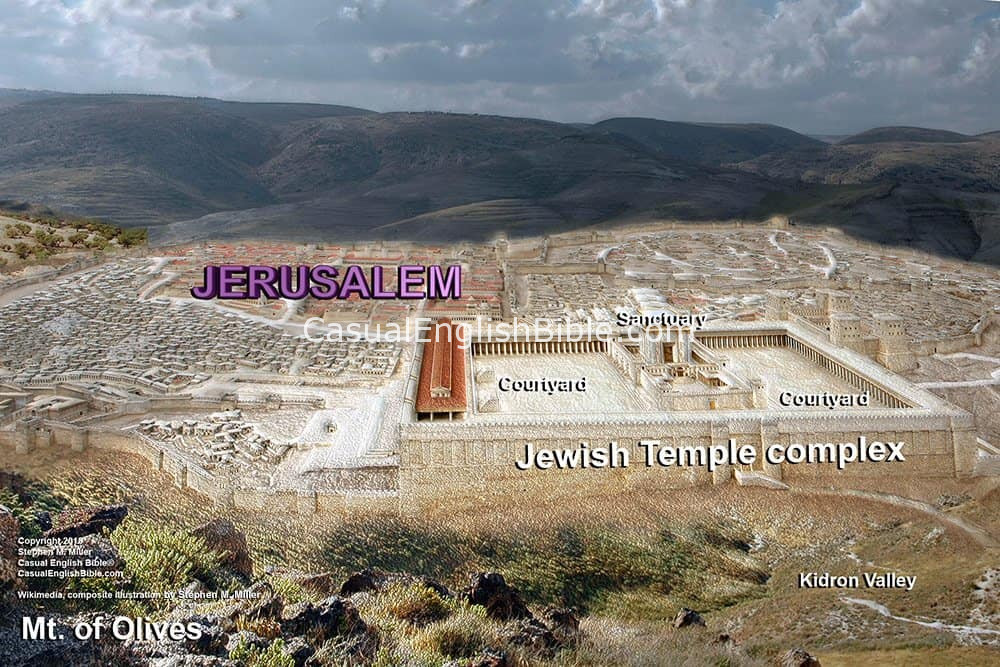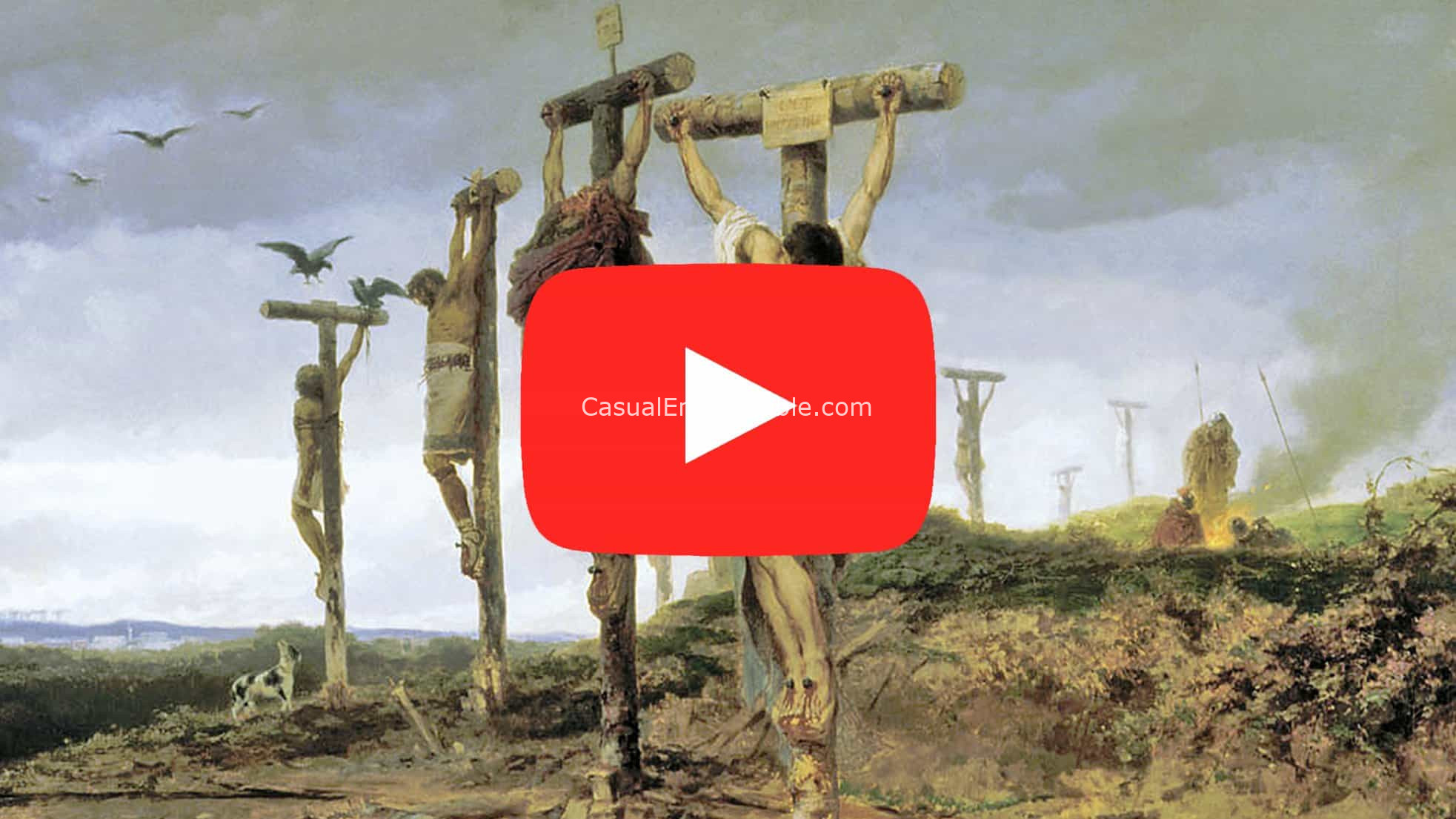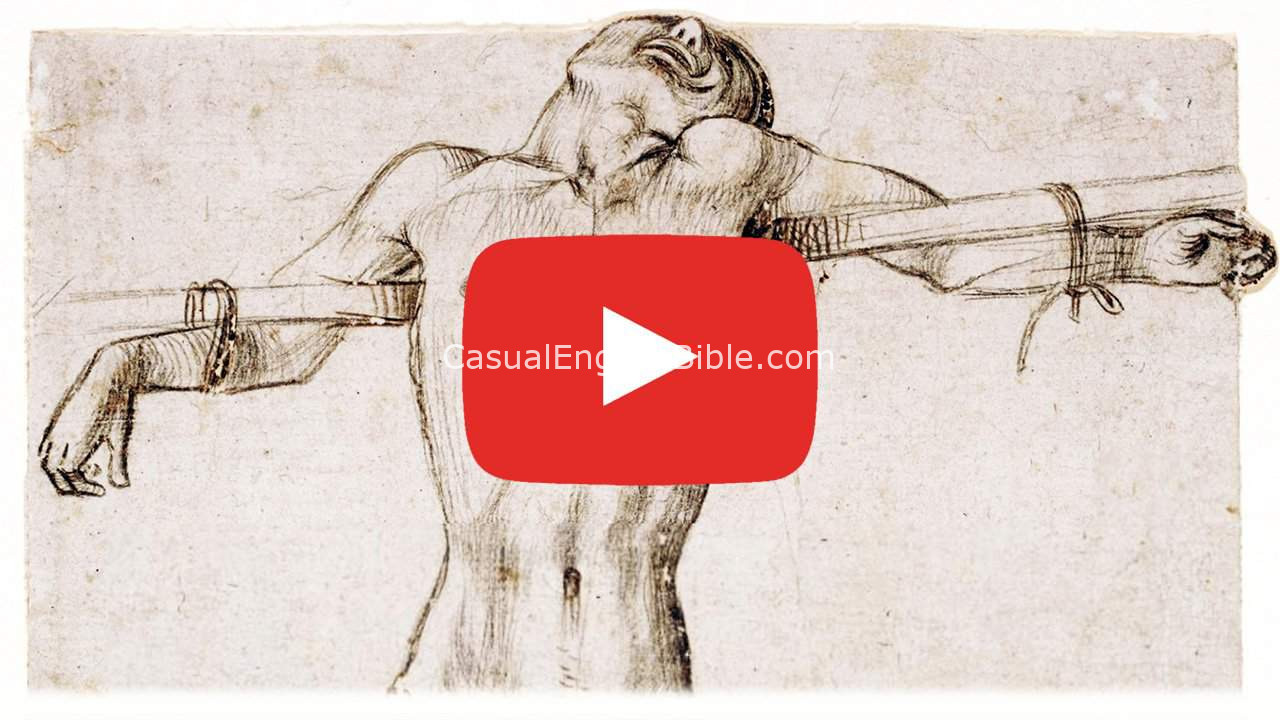Mark 15
Roman execution of Jesus
Jesus Meets Pilate
1Early in the morning the entire Jewish Council [1]—including the top priests, elders, and scholars known as scribes—decided what to do next. They tied up Jesus and took him to Pilate. [2]2Pilate interrogated Jesus, asking, “Are you the king of the Jews?”
Jesus answered, “You said it.”
3The top priests began unleashing a barrage of accusations against Jesus. 4Pilate turned to Jesus and said, “Are you going to stand there and say nothing? Are you listening to all these charges they are bringing against you?”
5Jesus didn’t answer him. He just stood there, which astonished Pilate. [3]
Free a Prisoner Day
6Pilate had a custom of releasing one prisoner during the annual Jewish celebration of Passover. He freed whichever prisoner the Jews wanted. 7One of the prisoners was a man called Barabbas. During a recent uprising against Rome, he committed murder. 8Some people in the crowd [4] asked Pilate to release one of the prisoners, as he usually did.9Pilate said, “Okay, fine. Would you like me to release the king of the Jews?” 10Pilate knew what was going on. He knew that the priests arrested Jesus because they envied his popularity. 11Quickly, the top priests started working the crowd. They told the people to demand that Pilate release Barabbas instead of Jesus.
12Pilate asked the people again, “So what do you want me to do with this man you call the king of the Jews?”
13The people screamed, “Crucify him!”
14Pilate said, “Why should I do that? What has he done wrong?”
But the crowd kept chanting, “Crucify him!”
15Pilate decided to give the crowd of Jews what they wanted. He released Barabbas. Then he sentenced Jesus to a beating followed by crucifixion.
Soldiers Make Fun of Jesus
16Soldiers took Jesus to the palace, which was the governor’s headquarters. [5] Then they mustered the rest of the soldiers. 17They dressed Jesus in the royal color: purple. [6] They made a crown by twisting together some thorn branches. They put it on his head. 18Then the soldiers cheered him, “Hooah, king of the Jews!”19They started hitting him on the head with a reed stick. They spit on him too. They dropped to their knees, which was the customary way of honoring a king. 20When the soldiers were done taunting Jesus, they stripped off the purple robe and put his own clothes back on him. Then they took him out to crucify him.
Jesus Crucified
21Along the way they met a man from the countryside who had come to Jerusalem. He was Simon of Cyrene, the father of Alexander and Rufus. Soldiers ordered Simon to carry the cross for Jesus. 22Soldiers led Jesus to a place called Golgotha, which means Skull. [7]23They offered Jesus what they said was wine, spiced with myrrh. [8] But he didn’t take it. 24They crucified him. Then they divvied up his clothes by throwing dice [9] to determine who got what.
25It was nine o’clock [10] in the morning when they crucified him. 26The sign posting the accusation against him read, “The King of the Jews.” 27Crucified with him were two robbers. One hung to the right of him and one to the left. 28This fulfilled the prophecy that said he’d be considered just another criminal. [11]
29Some of the people passing by hurled insults at him. Some shook their heads at him and said, “Well, well, well! Look at you now, the guy who said he would tear down the Temple and then build it back up in three days. 30Go ahead. Save yourself. Pop yourself down off of that cross.”
31Top priests and Jewish scholars known as scribes insulted him too. They said to each other, “He saved others, but for some reason he just can’t seem to save himself. 32If this Messiah, the king of Israel, wants to convince us that he really is the Messiah, he should just climb on down from that cross so we can see it with our own eyes.” The men crucified with Jesus started giving him a hard time too.
33At noon, the sky went dark. It stayed that way for the next three hours. 34That’s when, at three o’clock in the afternoon, Jesus screamed in Aramaic, [12] “My God, my God. Why have you left me?” [13]
35Some people standing nearby misunderstood him. They said, “Did you hear that? He’s asking for Elijah!” [14]
36So someone quickly soaked a sponge in wine that had soured into vinegar. They stabbed it with a stick and reached it up to him, offering him a drink. As they did, they said, “Pardon me, but let’s see if Elijah will show up and take him down.”
37With that, Jesus screamed his last breath.
38The curtain in the Temple ripped in two, from top to bottom. 39When the Roman centurion [15] saw Jesus die like this, he said, “There’s no doubt about it. This man was the Son of God!” [16]
40Women watched from a distance. The group included Mary Magdalene, along with Mary the mother of James the younger and of Joseph [17], and Salome. 41These women along with many others used to follow Jesus during his ministry in Galilee. They helped take care of him during his time there. They followed him from Galilee up to the hilltop city of Jerusalem.
Jesus, Dead and Buried
42It was now Friday evening. This is the day Jews prepare for their Sabbath day of rest and worship, which begins at sundown on Friday. 43Joseph of Arimathea, a respected member of the Jewish Council, went to Pilate and boldly asked for the body of Jesus. Joseph was expecting God to set up his kingdom soon.44Pilate was surprised to hear that Jesus was already dead. So he called for the centurion to confirm the death. 45When the centurion reported that Jesus was dead, Pilate released the corpse to Joseph.
46Joseph wrapped the body in a linen sheet and laid it in a tomb that had been cut out of rock. Joseph rolled the stone in front of the entrance to seal it closed. 47Mary Magdalene and Mary the mother of Joseph watched all of this closely. They saw where Joseph put the body of Jesus.
Footnotes
Known as the Sanhedrin, a group of about 70 Jewish leaders led by the high priest, who was Caiaphas at the time.
Pontius Pilate was the Roman governor of the province of Judea in what is now an area that includes Jerusalem and Tel Aviv. He ruled the region for a decade, from AD 26 to AD 36.
The Greek word to describe Pilate’s reaction is sometimes translated “amazed” or “surprised.” It can also mean “admired.” Some Bible scholars say Pilate looked kindly on Jesus because Jesus remained calm and dignified in the face of withering criticism.
The people who asked Pilate to honor his custom of releasing a prisoner may not have been the Jewish leaders who took Jesus to see Pilate. Others came to see Pilate in the morning for other reasons. The people who asked him to release a prisoner may have been friends of Barabbas.
The location was called the praetorium. Bible experts debate where in Jerusalem that may have been. Some have suggested a Roman fortress called Antonia, which was built beside the huge Jewish Temple. Soldiers stayed there. Others suggest it may have been in what used to be the palace of Herod the Great, which may have been where Pilate stayed when he was in town. Another tradition says it may have been in an auxiliary palace Herod maintained south of the Temple, near what is now the Jaffa Gate.
Purple was an expensive color because purple dye came from the murex snail in the Mediterranean Sea.
Bible experts resort to guessing about why the place was called Skull. Among the guesses: something about the area resembled a skull; as the place of crucifixion, there were some skulls in the area; the name came from a legend that the skull of Adam was buried there; there was a cemetery nearby, which is where the body of Jesus was placed.
Some Bible experts have said the soldiers were offering him a painkiller. But other scholars have said there’s no indication that myrrh is a painkiller. They say that this offer of wine probably came from the soldiers who were executing him. So perhaps they were continuing to taunt Jesus by lying and saying they were offering him what was considered fine wine. Other Gospel writers report that what the soldiers really offered Jesus was “some old wine that had turned to vinegar” (Luke 23:36). Mark mentions that kind of wine too (Mark 15:36).
A more literal translation would be they “threw lots.” This may have been something as simple as stones with some kind of marks on them. Romans did play dice. It was a popular game. Some played dice with stones that looked very much like the dice that people use today. Other Romans used knuckle bones from animals, such as sheep.
The Gospel of John says the Romans crucified Jesus three hours later, at about noon (John 19:14). In Greek, those times are referred to as the third hour and the sixth hour, because the day was considered to start at 6 in the morning, the first hour. Some Bible experts say the mix-up may have taken place in copying early manuscripts because the Greek letter representing the number three, gamma (Γ), may have been mistaken for the letter representing the number six, digamma(Ϝ). Other Bible experts say that the writer of the Gospel of John or a later editor may have bumped the time up to noon, to help Jewish readers recognize the symbolism behind the death of Jesus. Noon is when Jews typically sacrificed the Passover lamb. Christians teach that Jesus became the sacrifice to end all sacrifices (Hebrews 10:10).
This verse doesn’t show up in the oldest and most reliable copies of Mark. It’s similar to Luke 22:37, in which Jesus was apparently referring to a prophecy in Isaiah 53:12. The Greek word for “criminal” is anomos. It’s a word used to describe people who break the law, including rebels and sinners.
Aramaic was a common language spoken among the Jews. It may have been the language Jesus spoke most often. It came from Aram, now Syria, but it spread throughout the Middle East, becoming an international language. Jews picked up the language when Babylonians from what is now Iraq conquered their Jewish homeland in 586 BC and exiled most of the survivors to Iraq.
Bible experts can only speculate about why Jesus said this. Some say Jesus felt abandoned because the darkness represented God’s judgment against the sins of humanity, and the statement of Jesus suggests that God’s judgment fell on him. Others say Jesus was quoting a song that seems to predict some of the suffering he experienced, but that ends with an upbeat message, Psalm 22. It begins, “My God, my God, why have you abandoned me?” (22:1, New Living Translation). It talks about the people ridiculing him and shaking their heads at him (v. 7). It talks about throwing dice to divvy up his clothing (v. 18). It ends with the promise of hope that the poor will be fed, and people throughout the world will honor him (vv. 26-27).
In the Aramaic language that Jesus spoke, “My God” is Eloi (L-low), which sounds a little like “Elijah.”
Commander of a unit of 100 soldiers, and possibly the officer in charge of this execution.
The Roman soldier did not necessarily recognize the divinity of Jesus, as the Son of God. But at the very least he recognized him as either a child of God who was devoted to the Jewish God or as someone devoted to one of the other gods. Romans referred to Caesar as the “son of god.” The Roman soldier saw something unique about Jesus.
Mark reports the name in Greek as Joses, but Mark later calls him Joseph (15:47). So does Matthew (27:56).
Discussion Questions
- 1
When the top Jewish leaders sentenced Jesus to execution, they had to clear it with the Roman governor, Pilate. How do you think they would have felt about having to clear their executions with the occupying forces?
- 2
When Pilate asked if Jesus was king of the Jews, Jesus answered, “You said it” (Mark 15:2). That’s a strange answer, it seems. Bible translators aren’t sure what to do with it. One translation: “It is as you say” (New American Standard Version). Another: “Those are your words” (New Century Version). What do you think Jesus meant?
- 3
Pilate isn’t someone history describes as sympathetic to Jews. He slaughtered plenty of them. Mark doesn’t tell us why Pilate tried to free Jesus. Any guesses why Pilate tried three times (according to Luke’s version in Luke 23) to convince the crowd to let Jesus go?
- 4
History scholars have a theory about why Pilate gave in and agreed to execute Jesus. The theory is that Pilate was already on shaky ground with Rome because the man who had recommended him for the job, Sejanus, was executed by Emperor Tiberius in AD 31, for plotting a coup. Pilate didn’t want the Jews causing a ruckus or, worse, going to Rome with a complaint about him. What do you think about that theory?
- 5
“Pilate had a custom of releasing one prisoner during the annual Jewish celebration of Passover. He freed whichever prisoner the Jews wanted” (Mark 15:6). This was apparently a goodwill gesture to keep the Jews happy in spite of the fact that they were being occupied by the Roman Empire. Doesn’t that seem odd? Why would anyone think that releasing a prisoner would improve political relationships—especially a prisoner who happens to be a murderer?
- 6
Mark doesn’t say that the people in the crowd who asked Pilate to release one of the prisoners was among the group of people who brought Jesus to see him. Mark simply describes those folks as “some people in the crowd” (Mark 15:8). If those particular agitators had been members of the Jewish Council, we might expect Mark to say so. Pilate, like many Roman governors, typically held court early in the morning. People came to him for many reasons. Do you think it would make any difference to the story of Jesus if the people most interested in getting Barabbas freed were folks other than members of the Jewish Council?
- 7
Imagine Jesus during the taunting and beating that he got from the Roman soldiers (Mark 15:16-20). He gets dressed up like a king. He gets a crown of thorns jammed onto his head. Soldiers mock-cheer him for the fake king they seem to believe he is. They hit him on the head with a stick. They spit on him. What would you guess was going on inside the head of Jesus at the time? Was he numb? Was he terrified? Was he wanting to get it over with?
- 8
It’s anyone’s guess why people in Jerusalem called the execution site “Skull” (Mark 15:22). If you have heard any of the theories, what have you heard?
- 9
Twice in this chapter, Mark talks about Jesus being offered some kind of drink. As you read the story, do you think those drinks (Mark 15:23, 36) were offered as acts of compassion or as taunting?
- 10
Mark said Roman soldiers crucified Jesus at “nine o’clock in the morning” (15:25). John says they crucified Jesus at about noon (John 19:14). Scholars tackle this apparent discrepancy in a variety of ways. Which of the following approaches sounds most reasonable to you?
- Time rounded to nearest changing of the guard. Romans marked time by four change-of-the guard events every 12 hours: noon/midnight, three o’clock, six o’clock, nine o’clock. If Jesus was crucified sometime between nine o’clock in the morning and noon, some witnesses may have said it was closer to the nine o’clock event, while other witnesses may have said it was closer to noon.
- Typo. As explained in the footnote associated with Mark 15:25, someone recopying worn out early manuscripts confused the Greek letter representing third hour of the day (9 a.m.) gamma (Γ), with the Greek letter representing the number six, for the sixth hour of the day (noon) digamma (Ϝ).
- Poetic license for symbolism’s sake. John wanted to help Jewish readers see the symbolism behind the death of Jesus. Noon is when Jews sacrificed the Passover lamb. Jesus was the sacrifice to end all sacrifices (Hebrews 10:10).
- 11
Mark says that at noon “the sky went dark. It stayed that way for the next three hours” (Mark 15:33). He says that when Jesus died, “The curtain in the Temple ripped in two, from top to bottom” (Mark 15:38). Matthew said the ripped curtain took place during an earthquake. The International Geology Review confirms that there were two major earthquakes that hit the area between 26 BC and AD 36. Jesus died sometime between AD 30 and AD 33, scholars say. The curtain separated the Temple sanctuary from the holiest room in the building—the room where Jews had once kept their most sacred object: the chest that held the Ten Commandments, the ark of the covenant. Only the high priest could go in there, and only one day a year, on the Day of Atonement (Yom Kippur). That’s the day when the entire nation repented of their sins. Some Bible experts speculate that God was sending the signal that because Jesus died, we all have access to God and to his forgiveness. What do you think about that theory?
- 12
It seems to be unclear what the Roman centurion meant when, after Jesus died, he said, “This man was the Son of God!” (Mark 15:39). Given the setting, what do you think the centurion meant? Jesus was:
- the divine Son of God
- a child of God who was devoted to God
- divine, like Caesar, often described as the “son of god”
- a good man devoted to God (Luke 23:47)
- 13
When Joseph of Arimathea publicly asked for the body of Jesus so he could bury it, what do you think his buddies on the Jewish Council would have done to him when they found out?
- 14
LIFE APPLICATION. Joseph of Arimathea took a huge risk by taking a stand for Jesus. When have you seen someone do something like that—risking their reputation and perhaps even their livelihood for the sake of Jesus or out of respect for Christian principles?









